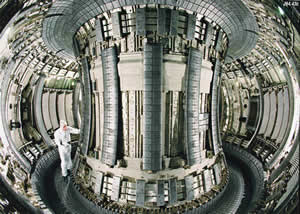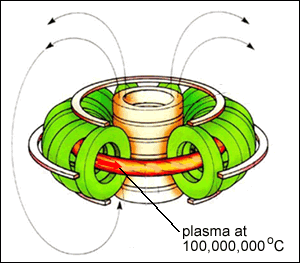Nuclear fusion
An environmentally friendly alternative.
Fusion is the energy source of the sun and other stars in the universe. On earth, fusion research is aimed at demonstrating that this energy source can be used to produce electricity in a safe and environmentally friendly way. Such an energy source would provide abundant fuel resources for the entire world.

As seen on the right, nuclear fusion reactions take place when two smaller nuclei collide with such force that they fuse. This releases a great deal of energy which can be harnessed to generate electricity. Temperatures in excess of 100,000,000oC are needed to initiate the fusion reactions. The abundant energy generated will then sustain the fusion reaction.
The fuel used is a mixture of hydrogen isotopes, namely deuterium and tritium which forms a plasma at such extraordinary temperatures. The hydrogen isotopes fuse to form helium and a lone neutron. Helium is not radioactive and therefore is environmentally safe.

It is one thing to recreate the sun but how do we contain the reactions without vapourising the reaction chamber and the surrounding countryside.
For many years this single problem has strained the imagination of many scientists. As the gas mixture of deuterium and tritium is heated to 100,000,000 oC a plasma is formed which must be kept away from the walls of the reaction chamber, otherwise, not only will the plasma cool down to below fusion temperatures but its walls will vapourise. It took the genius of two Russian scientists Igor Tamm and Andrei sakharov to come up with the answer. In 1950 while working at Moscow's Kurchatov Institute they developed the idea of the tokamak, pictured on the right.

The key feature of the tokamak is its central, hollow, donut shaped chamber. Huge electric currents pass through the coils surrounding the chamber and through the plasma inside it creating a powerful magnetic field that holds the plasma in place. The runaway neutrons have no charge and therefore not influenced by the strong magnetic field. Neutrons fly in straight paths and smash into the atoms of the reactor walls. During such collisions the considerable kinetic energy is transformed into heat energy which is used to heat steam to drive electrical generators.
Does it have any radioactive waste? The fact that the walls of the reaction vessels are constantly bombarded and absorbing runaway neutrons from the fusion reactions means that the metal forming the walls will become radioactive. However, unlike the waste from current nuclear fission reactors, the half life of the radioactive waste is only ten years. Hence in about one hundred years the radioactive material will decay to a safe level.

What are isotopes ?
What is a half life?
A nuclear fusion reaction to produce helium occurs between what isotopes?
What are the products of this nuclear fusion reaction?